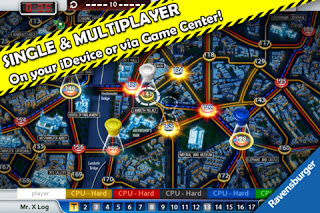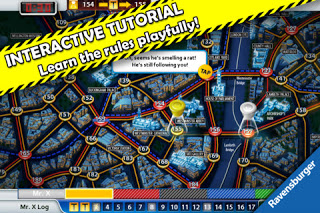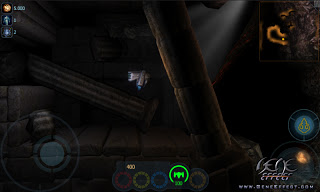Dragon Evolution [Nob Studio] – $1.99
Number of Results: 278
 For those of you, like me, who aren’t familiar with the game, it’s a simple premise. You either play as Mr. X, who is running from Scotland Yard, or as Scotland Yard, who is chasing down Mr. X. The board is made up of different stations, each linked together by colored lines. These colored lines show the means of travel between each of the stations. Taxi’s are yellow, busses are red, and the subway is blue. You’re given a certain number of tickets for each of the different means of travel, and use them to move about the city.
For those of you, like me, who aren’t familiar with the game, it’s a simple premise. You either play as Mr. X, who is running from Scotland Yard, or as Scotland Yard, who is chasing down Mr. X. The board is made up of different stations, each linked together by colored lines. These colored lines show the means of travel between each of the stations. Taxi’s are yellow, busses are red, and the subway is blue. You’re given a certain number of tickets for each of the different means of travel, and use them to move about the city.  With Scotland Yard being Universal, and with all of the multiplayer modes, the price-tag of $5 is very fair, especially when the original physical board game can costs anywhere between $25 and $40, and involves all of the setting up, clean up, and trying to find players who can sit around the board with you. Adding to the gameplay and replay value are 15 GameCenter achievements, some of which will require some very skillful gameplay. So you can add Scotland Yard to the list of board games that play fantastically on the iDevice, and cost a fraction of the price of the physical versions. The enhanced graphics, easy to learn gameplay, and high replayability make it a game that has the chance of staying on your device for as long as you own it. Also, being released by Ravensburger and FDG (Clear Vision, Cover Orange, Blueprint, Beyond Ynth, Tentacle Wars, and more) – you can be sure that it’s a high quality game, and that if any problems arise, they will be dealt with ASAP. Scotland Yard is highly recommended if you’re a fan of the genre, or if you’re looking for a game that the whole family can play.
With Scotland Yard being Universal, and with all of the multiplayer modes, the price-tag of $5 is very fair, especially when the original physical board game can costs anywhere between $25 and $40, and involves all of the setting up, clean up, and trying to find players who can sit around the board with you. Adding to the gameplay and replay value are 15 GameCenter achievements, some of which will require some very skillful gameplay. So you can add Scotland Yard to the list of board games that play fantastically on the iDevice, and cost a fraction of the price of the physical versions. The enhanced graphics, easy to learn gameplay, and high replayability make it a game that has the chance of staying on your device for as long as you own it. Also, being released by Ravensburger and FDG (Clear Vision, Cover Orange, Blueprint, Beyond Ynth, Tentacle Wars, and more) – you can be sure that it’s a high quality game, and that if any problems arise, they will be dealt with ASAP. Scotland Yard is highly recommended if you’re a fan of the genre, or if you’re looking for a game that the whole family can play.
Each Mission has certain objectives which you’ll need to achieve either before progressing to the next area of a level, or completing the stage. These range from collecting DNA samples, to finding different resources like Koronite (the main orange material which you’ll be collecting a ton of), and taking it to certain drop off areas within the levels, or collecting red, blue, and yellow crystal energy to start up reactors, as well as searching for sensors to unlock doors, and more.
 Lightstorm3D has definitely shown that they know exactly what it takes to make an amazingly immersive, incredibly depthy game with Gene Effect. The story, gameplay, graphics, controls, music, everything about the game really stands out as top-notch. Even without having GameCenter integration with no online achievements, or leader boards, it has a great amount of replay value that will drive completionists batty. Fans of exploration, sci-fi, mining, action, adventure and even puzzle games would do well to get this on their device as soon as possible. Gene Effect is definitely a game that stands out as a true console-like experience in an AppStore full of casual pick-up-and-play flash games. The $5 price of admission is well worth the journey you’ll be privileged to experience, and is highly recommended to all gamers looking for something more from the games on their iDevice. I sincerely hope iOS gamers will be able to see more from Lightstorm3D. It’s games like this that give me hope that the iDevice will grow into a serious gaming platform in the near future.
Lightstorm3D has definitely shown that they know exactly what it takes to make an amazingly immersive, incredibly depthy game with Gene Effect. The story, gameplay, graphics, controls, music, everything about the game really stands out as top-notch. Even without having GameCenter integration with no online achievements, or leader boards, it has a great amount of replay value that will drive completionists batty. Fans of exploration, sci-fi, mining, action, adventure and even puzzle games would do well to get this on their device as soon as possible. Gene Effect is definitely a game that stands out as a true console-like experience in an AppStore full of casual pick-up-and-play flash games. The $5 price of admission is well worth the journey you’ll be privileged to experience, and is highly recommended to all gamers looking for something more from the games on their iDevice. I sincerely hope iOS gamers will be able to see more from Lightstorm3D. It’s games like this that give me hope that the iDevice will grow into a serious gaming platform in the near future.